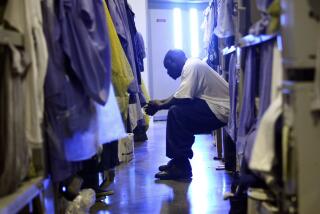Young killers serving life without parole may get chance at freedom
Reporting from Chowchilla, Calif. — She starting leaving home at 13, and soon she was gone for good. The streets drew her, the Barrio Pobre gang took her in.
She does not deny that at 16 she was there in Long Beach the night her boyfriend killed a younger girl in a gang dispute over a piece of jewelry.
Now she is 37, and though two decades have passed, Elizabeth Lozano still looks young — short, thin, with long black hair and expressive eyes. Even in her prison blues, she radiates youth, and she has won acclaim for reaching out to help teenagers in prison and others who are at risk of ending up there.
She was sentenced to life in prison with no possibility of ever being released, one of at least 2,500 inmates nationwide who were convicted of murder as juveniles, with no chance of parole.
“You feel hopeless,” she said, of having the jail door slammed shut on someone so young. “The smell, the noise. You feel like you are going to die in here.”
But now the U.S. Supreme Court and state lawmakers in Sacramento may give some of these inmates another chance. The court will hear oral arguments March 20, in two cases involving 14-year-olds, on whether it is unconstitutional cruel and unusual punishment to put young juvenile murderers in prison without hope of release.
The justices have been moving toward greater protection for minors. They abolished the death penalty for juveniles in 2005, and in 2010 ruled out life sentences without parole for them except in cases of homicide.
In Sacramento, a state Senate-passed bill to make juvenile murderers eligible for parole fell two votes short in the Assembly last year but is up for reconsideration this week.
The attorneys for the 14-year-olds point to forensic evidence that a teenager’s brain is not fully developed and that youths consequently take too many risks.
The research comes from Laurence Steinberg, a psychology professor at Temple University in Philadelphia. “Adolescents, because of their immaturity, should not be deemed as culpable as adults,” Steinberg said. “But they also are not innocent children whose crimes should be excused.”
Even if these inmates win in Washington or California, it does not mean they will all be released. They would have to prove to judges and parole boards that they deserve to go home, probably after they have served about 25 years. They would need to show near-unblemished prison records, true remorse and proof they can function in society.
Many will never get out. In the Chicago area, for instance, 17-year-old Johnny Freeman raped a 5-year-old and tossed her from a 14th-story window. Sixteen-year-old Peter Saunders bludgeoned an elderly woman, then from prison mailed a bomb-like device to a judge. David Biro, when he was a month short of 17, marched a husband and his pregnant wife down their basement stairs and shot them both.
Jennifer Bishop-Jenkins, sister of the soon-to-be-mother whom Biro killed, has worked tirelessly to block parole for juvenile murderers. “Most of these offenders are extremely guilty,” she said.
Maggie Elvey, who lost her husband of 29 years in a 1993 murder in the San Diego County city of Vista, is also not persuaded. “They knew darn well what they were doing,” she said of the two boys, 15 and 16, who beat him with a metal pipe. “Don’t believe those teenagers didn’t know the value of someone else’s life.”
Lozano knows that no matter what happens, it will not be easy for her to prove her case. For 20 years she has been preparing for just this moment, just this chance. “Every child is redeemable,” she said.
She was the oldest child and only daughter in a family with six children, in a home where she said the kids were beaten and she was sexually assaulted by an uncle.
“I wanted to be a teenager, but I couldn’t,” she recalled in the crowded visiting room at the state prison for women in Chowchilla. “I was a floater. I became a runaway, and I had nowhere to run to.”
She fled to Mexico after the shooting. Police found her four years later after she returned to Southern California as a mother. Her last moment of freedom was kissing her 4-month-old son goodbye. Kevin today is a high school senior, and this summer he plans to join the Marines.
Lozano was convicted of felony murder and robbery in the January 1992 shooting death of 13-year-old Tayde Vasquez in a fight over her jewelry at a park near the beach. Although Lozano later boasted that she shot Vasquez twice in the head, Lozano’s boyfriend, Steven Green, testified at her trial that he alone killed the girl. An adult, Green was convicted separately and was also given life with no parole.
“The girl was shot at point-blank range in the head,” prosecutor Julianne Walker recalls. “Over some gang rivalry. Two young girls, 16 and 13. Ugly. Ugly.”
At her sentencing, Lozano apologized to the Vasquez family. “All I could say was I was sorry,” she said. “That I was sorry for Tayde’s life being taken.”
When the judge gave her life with no parole, she said, “I couldn’t breathe. It was hard to breathe for a long time.”
For the first five years she kept to herself. As a lifer with no chance of parole, she initially was barred from prison self-help programs; they are reserved for inmates who actually might get out. But, she said, “I didn’t want to die in here.”
So she started remaking herself. She co-founded a Juvenile Offenders Program. She gave Skype presentations to hundreds of teenagers in the Central Valley. She volunteered on a “Scared Straight” project for at-risk kids. Once a high school dropout, she is working toward a college degree. She also works a janitor detail at the prison, clearing trash.
Her file is filled with testimonials lauding “her work ethic, positive attitude and exemplary behavior.” In interviews, the staff was complimentary, as were other inmates. The young ones see her as a mentor.
“Now she’s a grown woman,” said Alicia Freyding of Mexicali, Mexico, a former inmate who last year bunked with Lozano. “They’ve taken half of her life, and I think that has just made her stronger.”
Lozano said she cheers when other prisoners are paroled and is hopeful for herself. “We cannot keep throwing away children,” she said. “How can we say children cannot turn their lives around?”
More to Read
Sign up for Essential California
The most important California stories and recommendations in your inbox every morning.
You may occasionally receive promotional content from the Los Angeles Times.











